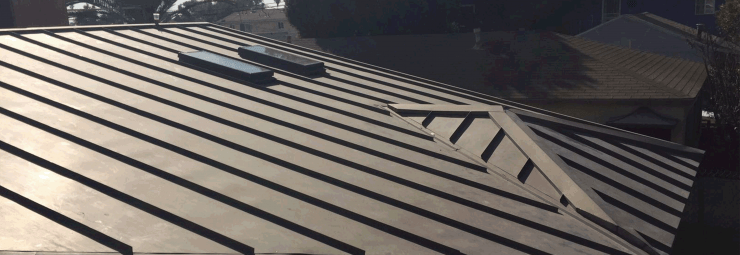Homeowners in southern California who are looking to have a roof replacement done on their property will find that they have several options from which to choose from. A careful examination of each will yield advantages and disadvantages in each, leaving the homeowner with a decision to make considering a number of different, relevant variables. Below, we outline some of the considerations related to metal roofing.
Advantages
1) Durability & Longevity
The majority of residential metal roofs use Standing Seam panels. There are four main types of standing seam panel: Double lock seam (or Mechanically seamed); Symmetrical seamed; One-piece snap-lock; and Two-piece snap-lock.
All of these offer advantages in longevity over traditional roofing materials (and corrugated roofing, for that matter). This is due to several factors:
- Minimal exposure of fasteners significantly reduces the potential for rust, oxidation and other corrosion (particularly valuable in coastal locations)
- Natural resistance to mold, moss and other organic substances that are detrimental to shingle roofs.
- Inherent structural advantages mean better ability to stand up to winds and other extreme weather.
Ultimately, these factors add up to a roof that has a much longer life than more traditional materials with expected life-spans of over 50 years.
2) Curb Appeal
Undoubtedly, aesthetics are one of the primary considerations for residential homeowners. Metal roofing offers a distinctive look with its uninterrupted clean lines that architects and homeowners find complementary to certain housing styles.
Furthermore, metal roofing panels can be made in a variety of materials and colors. Homeowners who’re looking to make a statement often choose bare copper roofing panels, while steel and aluminum panels can be painted in virtually any color to match a home’s decor.
3) Green Choice
Inherent longevity and efficiency give metal roofing an environmental edge over more common roofing materials:
- A combination of installation method, material and color can result in significantly reduced heat transfer through conduction. This can ultimately save the homeowner up to 30% on interior cooling costs in hotter environments
- A significantly lengthened lifespan means that metal roofs are removed far less frequently than traditional asphalt shingle. And, when they are removed, they’re 100% recyclable.
Taking these into consideration in combination with a lot of niche advantages (e.g. metal as the material of choice for efficient rainwater storage and irrigation systems) and the green edge of metal roofing becomes a serious point for consideration.

Disadvantages
1) Cost
Not a negative of the roofing itself, but there’s no denying that a metal roof is a significant investment for the homeowner and sometimes the initial cost can be prohibitive despite savings in the long term. Contact your local roofer for an estimate and weigh this one for yourself.
2) Aesthetics (Yep)
Not everyone is a fan of the metal roofing look. In fact, there are metal replications of nearly all traditional roofs. But, when it comes down to it, some homeowners who have a very specific decor in mind may not consider a metal roof to be an asset. Some Home Owners Associations frown upon metal roofing if they believe it to clash with the neighborhood’s aesthetic.
3) Scarcity of Qualified Manufacturers
In comparison to asphalt shingles, metal roofing is still somewhat unique in residential applications. For standing seam roofs, roof installers need to own (or have access to) fairly expensive metal fabrication equipment to manufacture custom panels. As a result, it may be difficult to find a qualified and fully equipped metal roofer depending on where you live.
